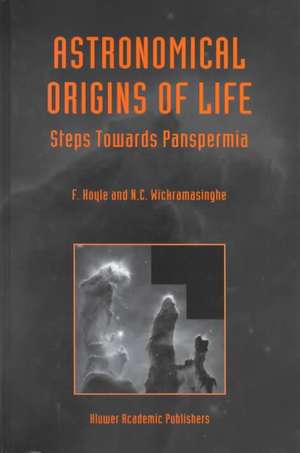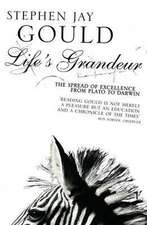Astronomical Origins of Life: Steps Towards Panspermia
Autor B. Hoyle, N.C. Wickramasingheen Limba Engleză Hardback – 30 apr 2000
| Toate formatele și edițiile | Preț | Express |
|---|---|---|
| Paperback (1) | 949.10 lei 6-8 săpt. | |
| SPRINGER NETHERLANDS – 13 oct 2012 | 949.10 lei 6-8 săpt. | |
| Hardback (1) | 958.88 lei 6-8 săpt. | |
| SPRINGER NETHERLANDS – 30 apr 2000 | 958.88 lei 6-8 săpt. |
Preț: 958.88 lei
Preț vechi: 1169.36 lei
-18% Nou
Puncte Express: 1438
Preț estimativ în valută:
183.57€ • 191.53$ • 153.88£
183.57€ • 191.53$ • 153.88£
Carte tipărită la comandă
Livrare economică 12-26 martie
Preluare comenzi: 021 569.72.76
Specificații
ISBN-13: 9780792360810
ISBN-10: 0792360818
Pagini: 381
Ilustrații: VIII, 381 p.
Dimensiuni: 155 x 235 x 22 mm
Greutate: 0.83 kg
Ediția:2000
Editura: SPRINGER NETHERLANDS
Colecția Springer
Locul publicării:Dordrecht, Netherlands
ISBN-10: 0792360818
Pagini: 381
Ilustrații: VIII, 381 p.
Dimensiuni: 155 x 235 x 22 mm
Greutate: 0.83 kg
Ediția:2000
Editura: SPRINGER NETHERLANDS
Colecția Springer
Locul publicării:Dordrecht, Netherlands
Public țintă
ResearchCuprins
Panspermia 2000.- 1. General Considerations.- On a Possibly Fundamental Principle in Chemistry as Viewed in a Cosmogonic Context.- Biological Activity in the Early Solar System in its Outer Regions.- An Object within a Particle of Extraterrestrial Origin Compared with an Object of Presumed Terrestrial Origin.- The Viability with Respect to Temperature of Micro-Organisms Incident on the Earth’s Atmosphere.- A Laboratory Experiment with Relevance to the Survival of Micro-Organisms Entering a Planetary Atmosphere.- Biological Evolution.- Metallic Particles in Astronomy.- The Universe and Life: Deductions from the Weak Anthropic Principle.- Miller-Urey Synthesis in the Nuclei of Galaxies.- 2. Cosmic Organic Polymers.- Formaldehyde Polymers in Interstellar Space.- Formaldehyde Polymers in Comets.- Composition of Cometary Dust: the Case against Silicates.- Primitive Grain Clumps and Organic Compounds in Carbonaceous Chondrites.- Spectroscopic Evidence for Interstellar Grain Clumps in Meteoritic Inclusions.- Calculations of Infrared Fluxes from Galactic Sources for a Polysaccharide Grain Model.- 3. Cosmic Micro-Organisms: Infrared Characterisation.- Infrared Spectroscopy of Micro-Organisms Near 3.4 ?m in Relation to Geology and Astronomy.- Infrared Spectroscopy over the 2.9-3.9 ?m Waveband in Biochemistry and Astronomy.- 2.8-3.6 ?m Spectra of Micro-Organisms with Varying H2O Ice-Content.- Organo-Siliceous Biomolecules and the Infrared Spectrum of the Trapezium Nebula.- The Spectroscopic Identification of Interstellar Grains.- The Availability of Phosphorus in the Bacterial Model of the Interstellar Grains.- Diatoms on Earth, Comets, Europa an. i. Interstellar Space.- A Diatom Model of Dust in the Trapezium Nebula.- Infrared Evidence for Panspermia: An Update.- 4. Evidencefrom Interstellar Extinction.- On the Nature of Interstellar Grains.- A Model for Interstellar Extinction.- The Ultraviolet Absorbance of Presumably Interstellar Bacteria and Related Matters.- The Case against Graphite Particles in Interstellar Space.- 5. Biogenic Aromatic Molecules in Space.- Organic Molecules in Interstellar Dust: A Possible Spectral Signature at ?.2200Å?.- Identification of the ? 2 200 Å Interstellar Absorption Feature.- A Unified Model for the 3.28 ? Emission and the 2200 Å Interstellar Extinction Feature.- Aromatic Hydrocarbons in Very Small Interstellar Grains.- An Integrated 2.5-12.5 ?m Emission Spectrum of Naturally-Occurring Aromatic Molecules.- Biofluorescence and the Extended Red Emission in Astrophysical Sources.- 6. Comets and Life.- Comets, Ice Ages, and Ecological Catastrophes.- Comets - A Vehicle for Panspermia.- Some Predictions on the Nature of Comet Halley.- A Model of the 2-1 ?m Spectrum of Comet Halley.- Modelling the 5-30 ?ectrum of Comet Halley.- Very Small Dust Particles (VSDP’met C/19962 B2 (Hyakutake).- The Astonishing Redness of Kuiper-Belt Objects.- Eruptions of Comet Hale-Bopp at 6.5 AU.- Infrared Radiation from Comet Hale-Bopp.















